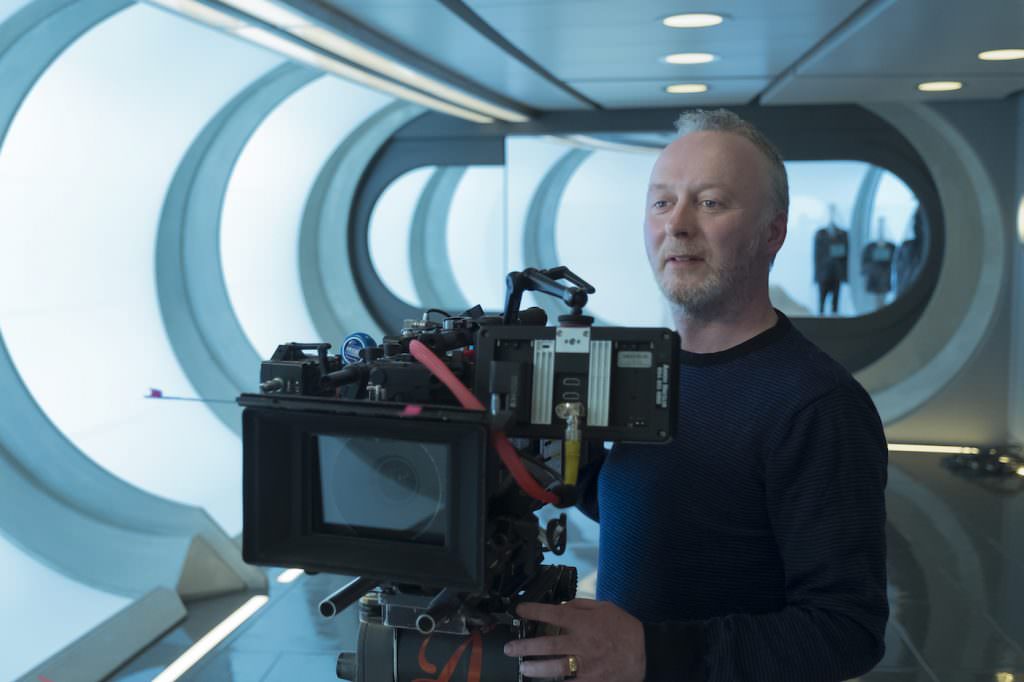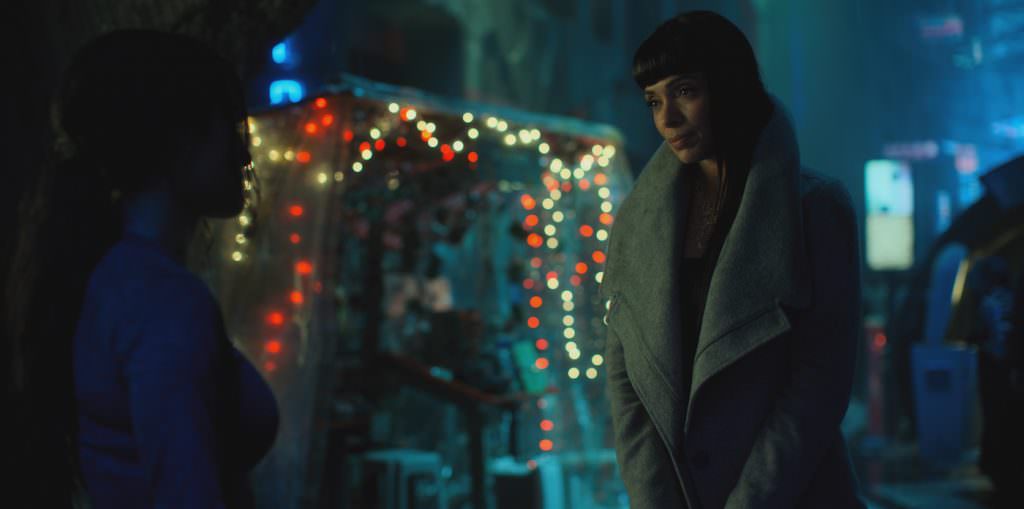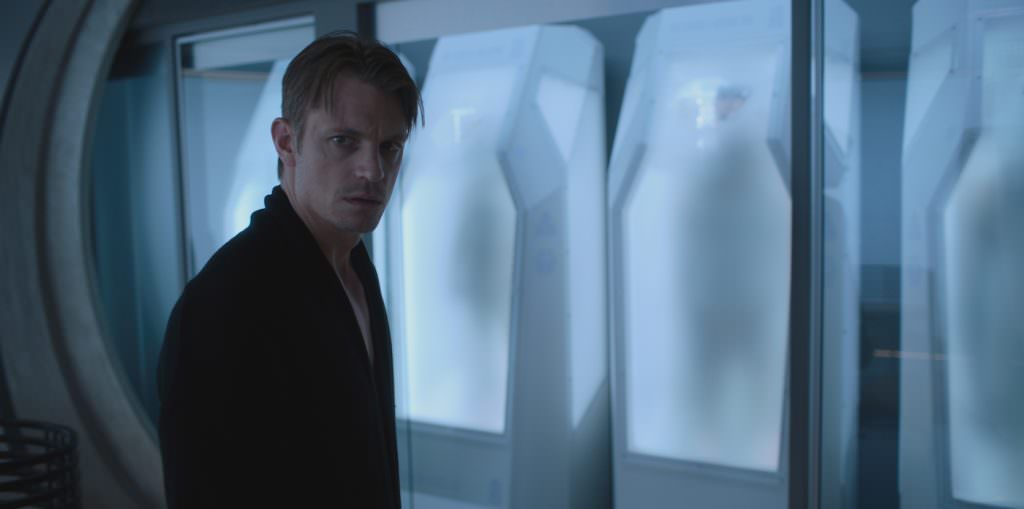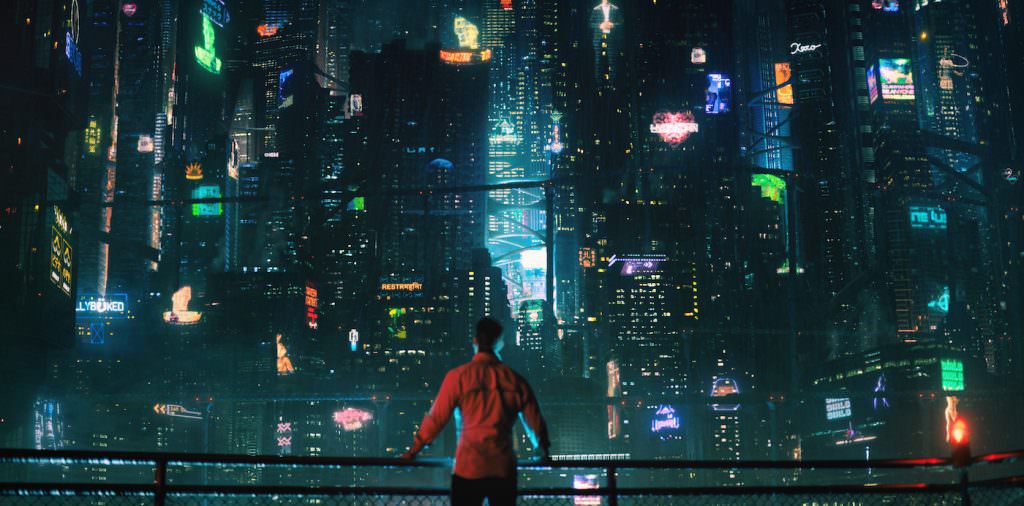Cinematographer Neville Kidd on Visualizing Netflix’s Epic New Sci-Fi Series Altered Carbon
In sci-fi series Altered Carbon (streaming Friday, Feb 2, on Netflix), the streets of San Francisco 350 years in the future teem with pulsating 3D ads, flying cop cars, prostitute holograms and “sleeves,” formerly known as human bodies, embedded with “cortical stacks” of consciousness that enable rich people to live forever. Inhabiting one of those sleeves is recently resurrected rebel soldier Takishi Kovacs (Joel Kinnamen of The Killing), who prowls the city in search of his wealthy patron’s killer. Cinematographer Neville Kidd illuminated the dystopian landscape with ever-mutating blasts of color and shadow in accordance with executive producer Laeta Kalogridis’s creative brief. “Laeta wanted Altered Carbon to have this futuristic noir kind of feel, but we didn’t want it to be too dark,” says Kidd. “We used color to show that people are attacked visually from all sides and being over-stimulated by things like 3-D hologram advertising.”
https://www.youtube.com/watch?v=dhFM8akm9a4
Kidd and co-cinematographer Martin Ahlgren infused many Altered Carbon sequences with teal, blue and greenish-blue cyan tones. “The moonlight’s been hijacked by all the holograms and advertising and moving traffic,” says Kidd. “Martin and I tried to keep it busy and create a world that really sucked the viewer in to the emotional journey of Joel Kinnamen’s character. That’s what you do as a DP: you take the show runner’s vision, the director’s storytelling, and then you add your visuals to lure the audience in for the duration for the show.”


Altered Carbon‘s moody color scheme comes to life on the small screen courtesy of the Alexa 65 large format digital camera. Kidd, now in Toronto to work on Ellen Page’s new series The Umbrella Academy, says “The 65 has this fantastic sensor that gave us much more depth of color and allowed us to capture a much more cinematic look.” The difference between standard TV visuals and Altered Carbon imagery comes down to information, he says. “The 65 sensor gave us 13 times the amount of data you’d get from a normal Alexa. We gained a lot of control over the color and depth of field, and a much more subtle range of colors including the red tones.”
While VFX company Double Negative Television worked on the series’ intensive visual effects, Kidd shot one stand-alone “prequel” episode in the Rocky Mountains but spent most of his eleven months inside Sky Dance soundstage near Vancouver. The former printing press facility accommodated a 500-foot long marketplace set. There, Kidd shot actors against greenscreen backdrops. To make the space pop, he coordinated camera moves with a massive LED lighting system. “We were able to change colors much faster than if we’d used gels,” Kidd says. “We fed the colors through the lighting board operator which allowed us to make the colors pulse, grow darker, or grow lighter.”
Blending the LED light environments with traditional “hard light” to accentuate shadows and create tension, Kidd favored hand-held cameras when shooting gritty streets traveled by the 99 percenters known as “Grinders.” By contrast, he deployed remote-controlled techno-cranes to capture the world of the ruling elite. And then there were the fight sequences, which unspool with dizzying intensity thanks to high-speed Phantom cameras mounted on a circular track. “I told the grips I wanted the camera going around as fast as humanly possible short of flying off the tracks,” Kidd recalls. “They created a fantastic rig that enabled the camera to going insane fast, practically like a little rocket.”


Prior to Altered Carbon, Kidd shot a season of Dr. Who and earned an Emmy for his mind-melting camera work on Benedict Cumberbatch’s Sherlock series, but he’d never tunneled into full-blown sci-fi dystopia. In fact, the Vancouver shoot represented an extreme change of sensibility for Kidd: before moving west to shoot Altered Carbon. He filmed 18th-century time travel romance Outlanders in his native Scotland. “I really wanted to capture the majesty of the natural light in Scotland to show why this woman from 1950s was lured into such a hard, brutal world,” Kidd explains. “For one of our Braveheart-type scenes, we actually had the shafts of sunlight coming down fro the sky through like the fingers of God.”


Although Altered Carbon traverses much darker terrain, Kidd found a glimmer of hope in the violent cautionary tale. “I was actually kind of inspired by working on Altered Carbon,” Kidd says. “It has an important message: If you don’t keep the rich in check, here’s what it’s going to look like. If society allows the gaps between rich and poor to get out of control, this is what happens.”




